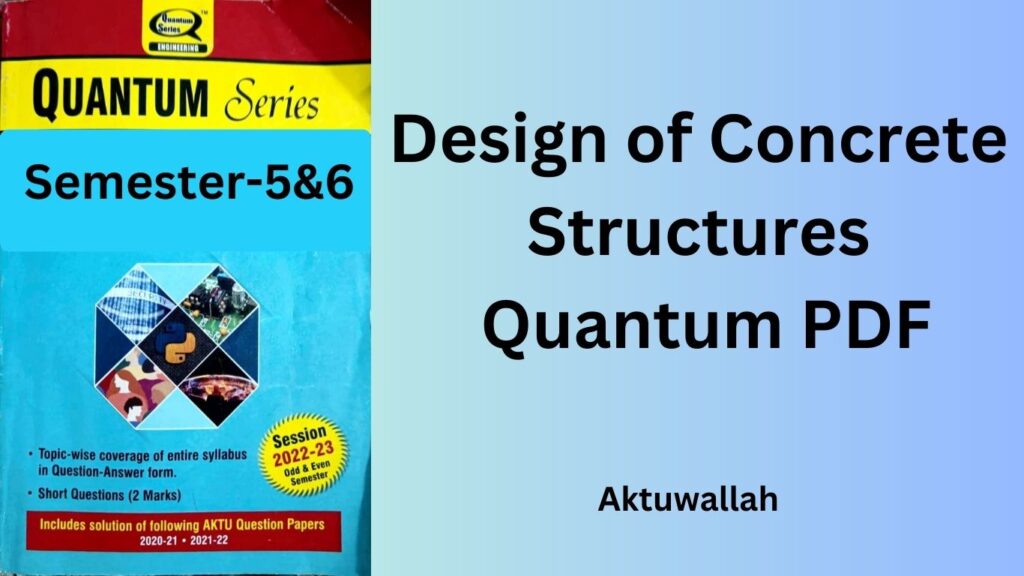AKTU B-tech 3rd Year Design of Concrete Structures Quantum PDF:
Concrete structures are the backbone of modern infrastructure, providing stability and durability to a wide range of constructions. In the third year of the B-tech program at AKTU (Dr. A.P.J. Abdul Kalam Technical University), students dive into the intricacies of designing concrete structures. This article aims to provide insights into the key topics covered in the Design of Concrete Structures course, offering a concise overview in a downloadable PDF format.
How to download Design of Concrete Structures Quantum PDF for free?
Download Now
Download Other Civil Engg quantum pdf for Aktu B-tech 3rd year: Click Here
Download Aktu Syllabus of Civil Engg B-tech 3rd year: Click Here
Download Handwritten Notes of all subjects: Click Here
Download Design of Concrete Structures PYQs: Click Here
Table of Contents
- Introduction to Concrete Structures
- Importance of Concrete in Construction
- Properties of Concrete Material
- Role of Reinforcement
- Basics of Structural Design
- Load-Bearing Principles
- Safety Factors and Load Combinations
- Structural Integrity and Redundancy
- Concrete Mix Design
- Proportioning of Ingredients
- Workability and Durability
- Special Concrete Mixes
- Principles of Reinforcement
- Types of Reinforcement
- Tensile and Compressive Forces
- Bond between Concrete and Reinforcement
- Flexural Analysis and Design
- Behavior of Beams under Load
- Moment-Curvature Relationship
- Design of Rectangular and T-beams
- Shear and Torsion
- Shear Resistance Mechanisms
- Shear Reinforcement
- Torsional Behavior of Beams
- Column Design
- Axial Load-Bearing Capacity
- Slenderness Ratio and Buckling
- Design of Short and Long Columns
- Footing and Foundation Design
- Types of Footings
- Bearing Capacity of Soil
- Mat and Raft Foundations
- Design for Earthquake Resistance
- Seismic Forces on Structures
- Reinforcement Detailing for Seismic Zones
- Retrofitting Techniques
- Prestressed Concrete Design
- Advantages of Prestressed Concrete
- Pre-tensioning and Post-tensioning
- Design of Prestressed Beams
- Special Concrete Structures
- Design of Retaining Walls
- Water Tanks and Silos
- Design Challenges for Unique Structures
- Construction Management and Quality Control
- Site Preparation and Safety Measures
- Quality Assurance in Concrete Construction
- Non-Destructive Testing
Exploring the Key Topics of Design of Concrete Structures Quantum PDF
Introduction to Concrete Structures
In the Design of Concrete Structures course at AKTU, students are introduced to the fundamental concepts of concrete behavior and structural design. The course delves into the properties of concrete as a construction material and explores the interaction between concrete and reinforcement.
Basics of Structural Design
As part of the curriculum, students learn the principles of load-bearing design, understanding how different loads impact the stability and safety of structures. They also grasp the significance of factors like safety margins, redundancy, and structural integrity in ensuring the reliability of concrete structures.
Concrete Mix Design
Concrete mix design is another crucial aspect covered in the course. Students learn to proportion concrete ingredients to achieve desired workability, strength, and durability. This knowledge is essential for creating concrete mixes that meet specific project requirements.
Principles of Reinforcement
Reinforcement principles are central to the course. Different types of reinforcement and their roles in withstanding tensile and compressive forces are thoroughly explained. Students gain insights into the bond between concrete and reinforcement, ensuring effective load transfer.
Flexural Analysis and Design
One of the core modules focuses on flexural analysis and design, where students understand how beams respond to various loads and forces. They learn to calculate moments and curvature relationships, enabling them to design beams that can withstand real-world conditions.
Shear and Torsion
Shear and torsion are critical aspects in structural design, particularly in ensuring the integrity of beams and columns. The course teaches students the mechanisms of shear resistance, the need for shear reinforcement, and how torsional forces impact structural elements.
Column Design
Column design and footing design are equally significant topics. Students learn about axial load-bearing capacities, slenderness ratios, and the design considerations for different types of columns and foundations.
Design for Earthquake Resistance
The course also addresses earthquake-resistant design, an essential skill given the seismic nature of some regions. Students explore methods to reinforce structures against seismic forces and learn about retrofitting techniques for existing structures.
Prestressed Concrete Design
Prestressed concrete design is an advanced module where students understand the benefits of prestressing and the methods involved. They grasp the intricacies of pre-tensioning and post-tensioning, and how these techniques enhance the load-bearing capacity of structures.
Special Concrete Structures
Special concrete structures like retaining walls, water tanks, and unique architectural designs are also covered. Students learn the specific considerations for these structures and how to overcome design challenges.
Construction Management and Quality Control
Quality control and construction management complete the curriculum, emphasizing the significance of site safety, quality assurance, and non-destructive testing in ensuring the longevity and reliability of concrete structures.
In conclusion
The AKTU B-tech 3rd Year Design of Concrete Structures Quantum PDF provides students with comprehensive knowledge about designing robust and resilient concrete structures. The course covers a wide range of topics that are essential for anyone venturing into the field of civil and structural engineering.
1 thought on “Download Design of Concrete Structures Quantum PDF”